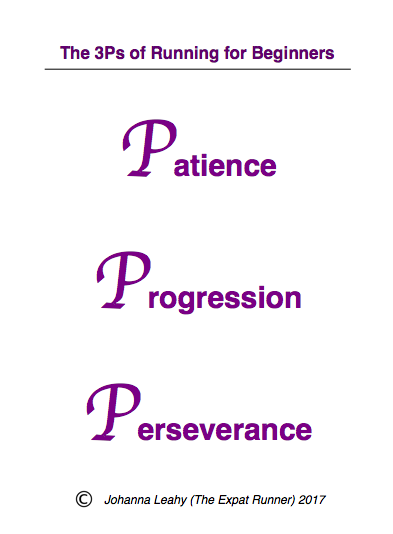‘I’ve always wanted to run but it feels so hard and I’ve never managed to get that runners high you hear about,’ a new acquaintance lamented to me recently.
Firstly I was amazed by the lady’s desire to run. As passionate as I am about running, up until six years ago I had never had the remotest urge to do so. FOMO was my reason to start; desire didn’t come into it. And wanting to run, doesn’t mean it’s going to be easy. The truth is that there is a lot of groundwork to be done in the first few weeks and months of running. Everyone, even those who consider themselves fit and active, find running difficult to begin with. The trick, my friends, is to remember the 3Ps. Keep these in mind, especially when you’re struggling, and you will optimise your chance of acquiring a fourth P – passion! – just as I did. (The ingredients needed for a runner’s high – the fifth and sixth Ps – pace and performance – will surely follow).
P1 PATIENCE
Unless you are five years old or unusually genetically gifted, you are not going to get up one morning, lace up your shoes, and run 5km in 25 mins. If somehow you do, it’s safe to say that you won’t be able to lace up your shoes again for a while because along with other parts of you, your hamstrings will be so tight and sore that you won’t be able to reach your feet. The reason that it takes time to build up a running habit, is that the body, or at least the parts of the body that are engaged in running, are not instant gratification machines. Your cardiovascular and musculoskeletal need time to adjust to a new level of activity and loading, and if you don’t respect the time required for your lungs, muscles and connective tissues to adapt, they will penalise you with discomfort and injury. And like my new acquaintance, you might at this point give up on the whole running idea altogether – sore and defeated.
The great news is that you will probably feel a bit fitter after only a few runs but remember that your ligaments and tendons take as long as four weeks to adapt to the new loads you’re imposing on them. Do not look at people who can run 10km in 45 mins and think resentfully that you’re just as lean and fit from your gym workouts as they are, so why can’t you run like they do? Don’t look at them and think that because you’re not as lean and fit as them that you never will be able to run as they do. Running has its own set of unique physical requirements so be patient, keep your eyes on the long game, and consider those early weeks and months of doing short, easy runs (or walk-runs) as an investment in your long term goal – whether that be to run 5km continuously in 35 mins or complete a half marathon before you turn 50. Remember you want to get into running for the longterm which ironically demands that you should not be in a big hurry to speed up – to start with at least.
P2 PROGRESSION
The main injury-prevention tool for new runners is to progress slowly. A couch to 5km program is ideal as it combines walking and running, with the walking intervals shortening and the running intervals lengthening, as the weeks progress. Within 10-12 weeks of thrice-weekly sessions, most people can manage a 5km at a slow pace. Remember to look at your total number of kilometres in a week and resist the urge to get carried away when you’re feeling good – it’s a good rule of thumb to avoid ramping up weekly mileage by more than 10% at a time. Slow progress is key. Train yourself to achieve a base mileage that is comfortably challenging over a period of months before you even consider starting any kind of speed workouts or races.
P3 PERSEVERENCE
In the early days of running, before you’ve trained that little nagging voice in your brain to shut-up and stop telling you that you need to quit, that you’ll never be able to run far, perseverance is key. It will be hard. Accept that and keep trying. You might look at other runners, who make it look easy. But you can’t hear what’s going on in their heads no more than they can hear what’s in yours. The brain is one of running’s greatest tools – and beneficiaries – so train it in tandem with your lungs and legs. Run with a friend if you can; conversation is a great distraction from discomfort. Like and read running pages on Facebook and Instagram to keep you motivated. Remember that everyone, even Mo Farah, has bad days. The important thing is not to give up when the going gets tough. Persevere!

I explained the 3Ps to my new acquaintance, hoping to encourage her to give running another go. I invited her to come along to my next coaching class for free. She said that she would, but in the end she messaged me to say that her foot was sore but she’d try again the following week. I really hope she does. The 3Ps are essential components of a beginner runner’s tool kit but of course to use them you first have to show up.


